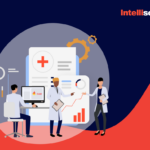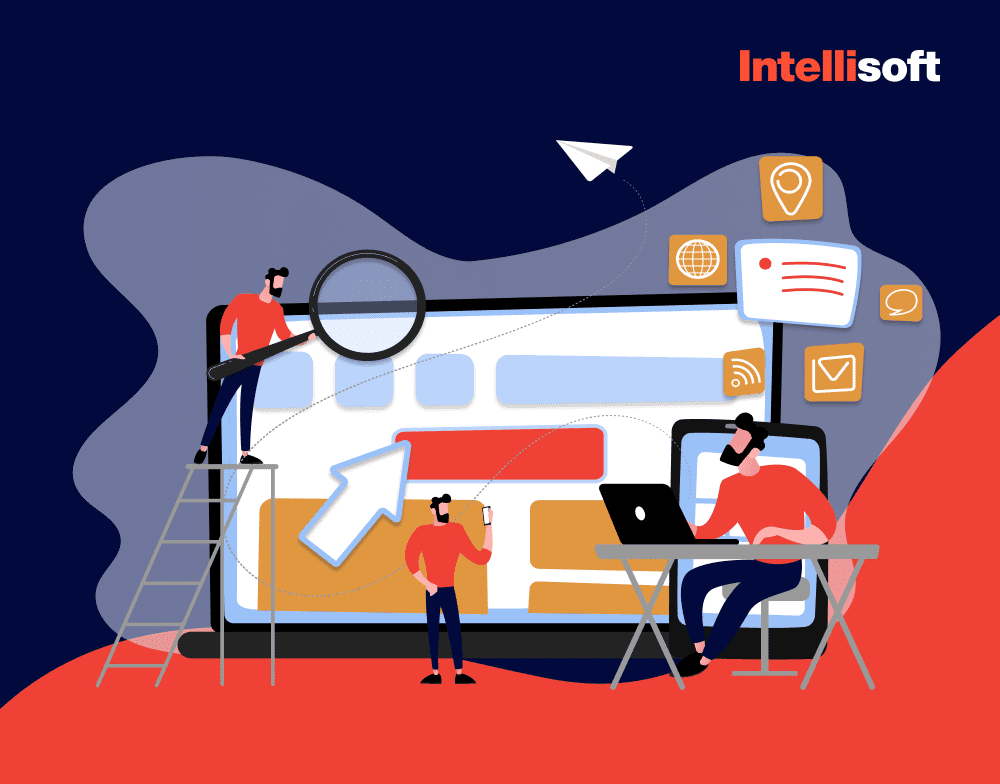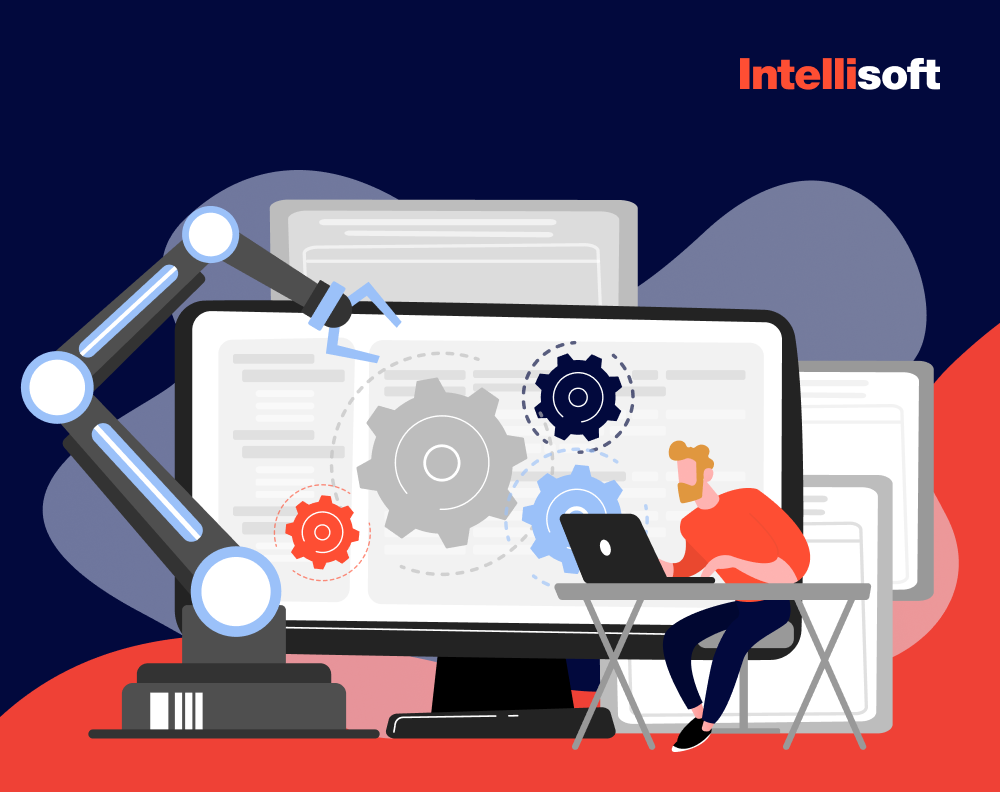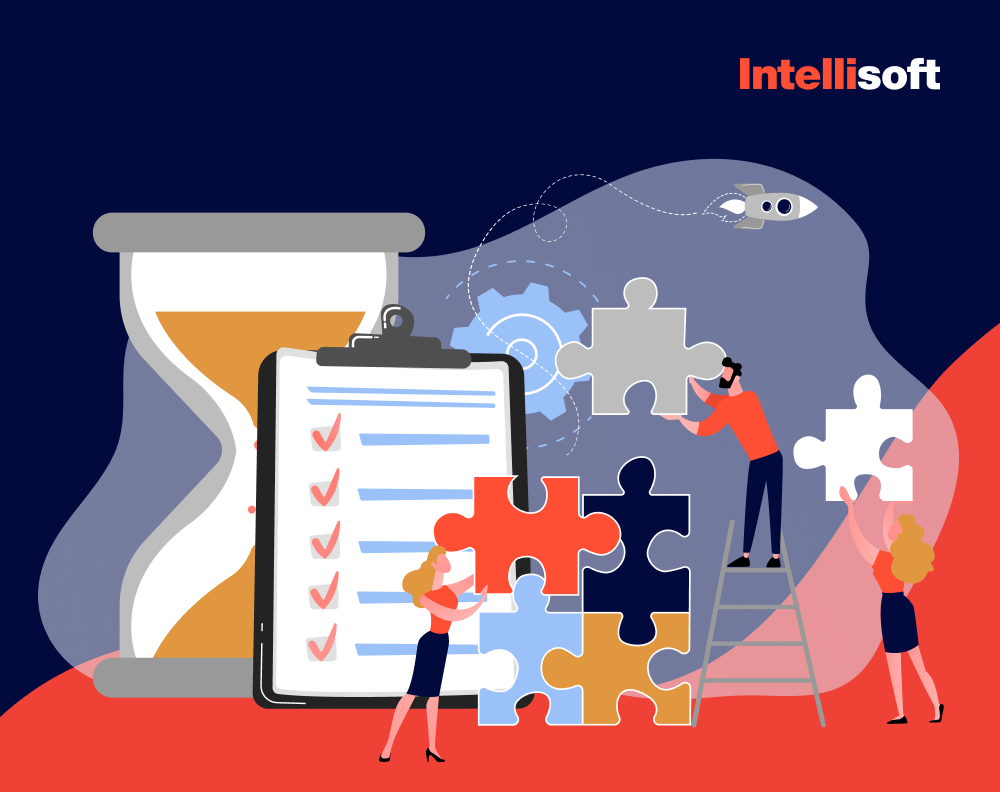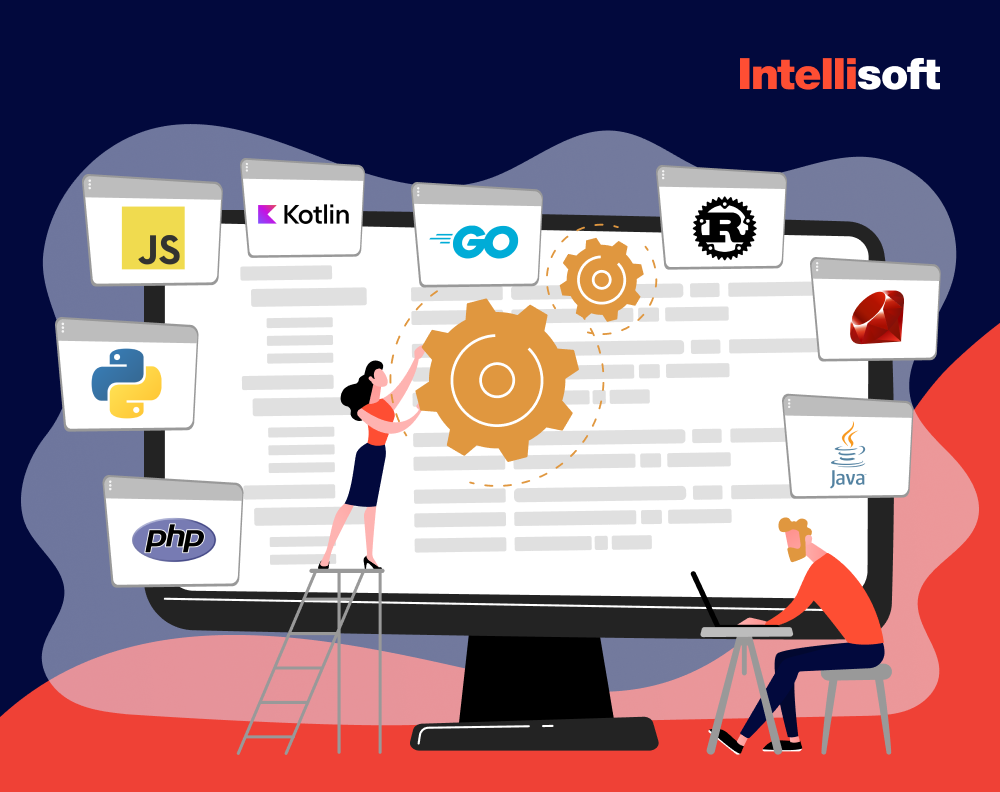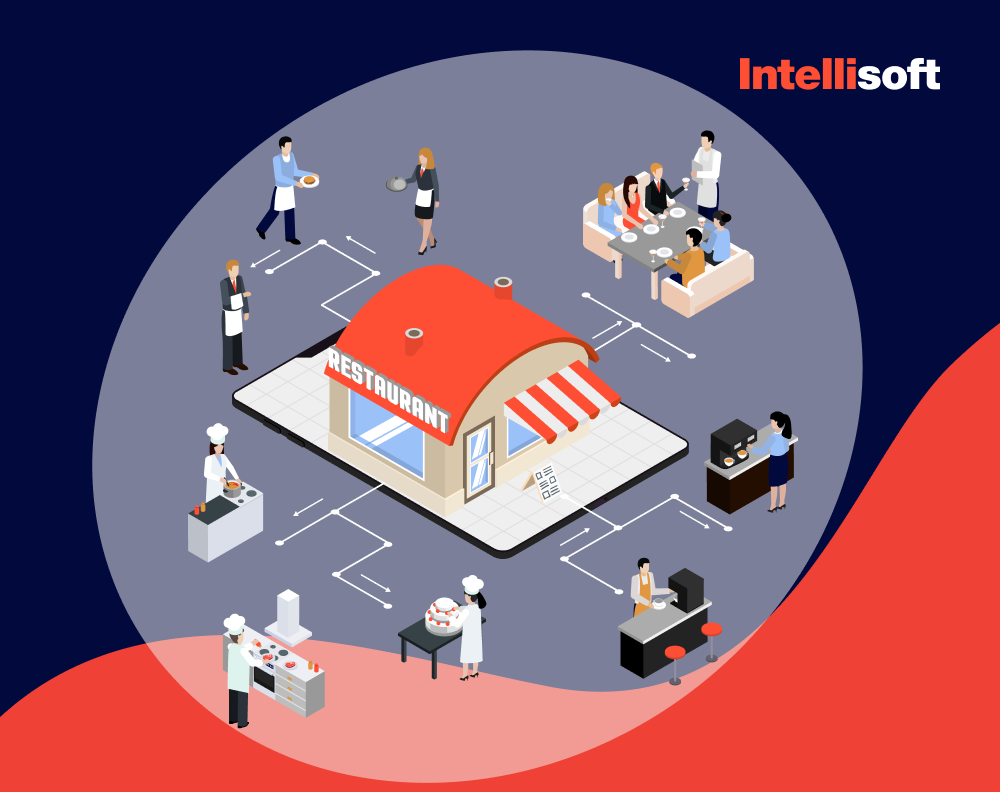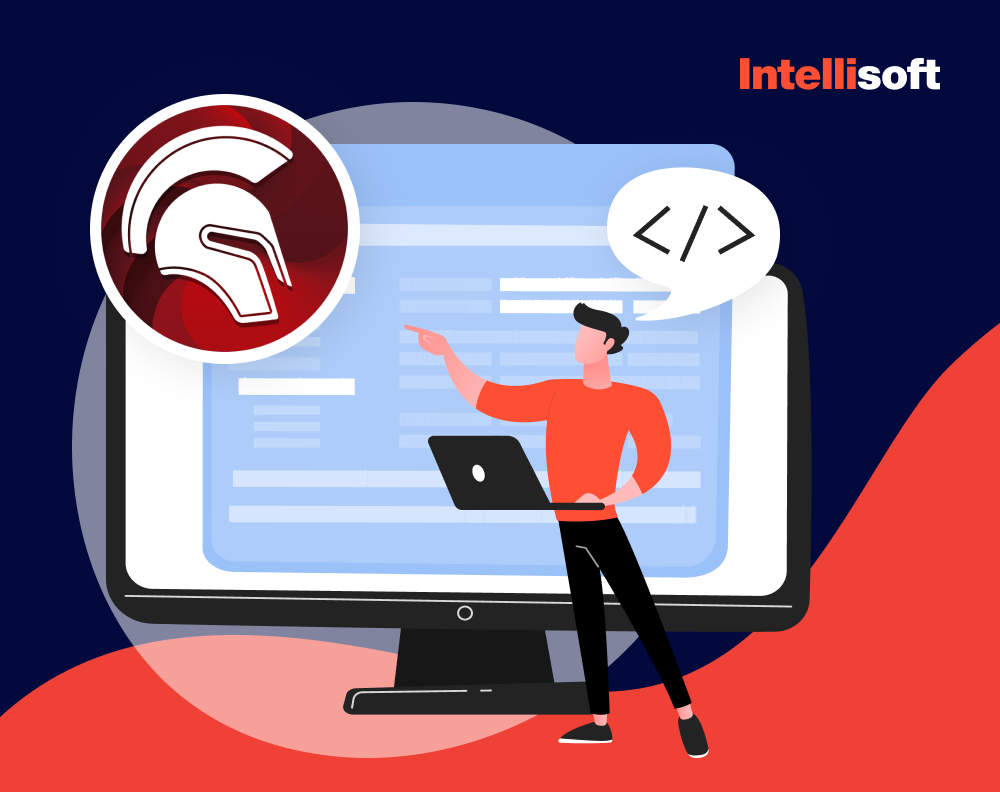In restaurant management, success hinges on more than just the quality of the cuisine; your chefs can be maestros of exquisite meals, preparing food from refined ingredients, but if your processes are not automated and you don’t have a proper billing software system in your restaurant, your customers will never be fully satisfied.
Think of it this way; your kitchen operates like a well-oiled machine, with chefs orchestrating a symphony of flavors. However, with an efficient billing software system in place, the harmony of the dining experience can be maintained.
The global restaurant billing software market is booming right now, expected to reach $7916.7 million by 2031, with a CAGR of 6.98%. These numbers prove that having a reliable POS (point of sale) is essential if you want your restaurant to stay competitive in the market and offer top-notch service to your customers.
Should you choose among ready-made POS billing software for restaurant or opt for a custom one? In this article, we’ll help you decide what will work best for you and share our knowledge and experience as a development partner with 13+ years in the industry. IntelliSoft will become your guide and partner in the journey of your restaurant’s success, so hop on, and let’s explore.
Table of Contents
What is Billing Software for Restaurants?
Billing software for restaurant is the digital backbone of modern dining establishments, offering a streamlined solution for managing transactions, processing payments, and generating accurate bills. It’s a specialized tool designed to automate and simplify the complex task of handling financial transactions in a restaurant.
Software for restaurant billing is also known as a POS (point of sale) system for managing and processing orders, tracking sales, managing inventory, and monitoring sales performance. Even though the primary goal of a POS system is to manage customer billing and the process of sales, this software can do much more than that, influencing the overall effectiveness of the restaurant and customer satisfaction.
Workflow of Restaurant Billing Software
Here’s an illustration of a restaurant billing system workflow:
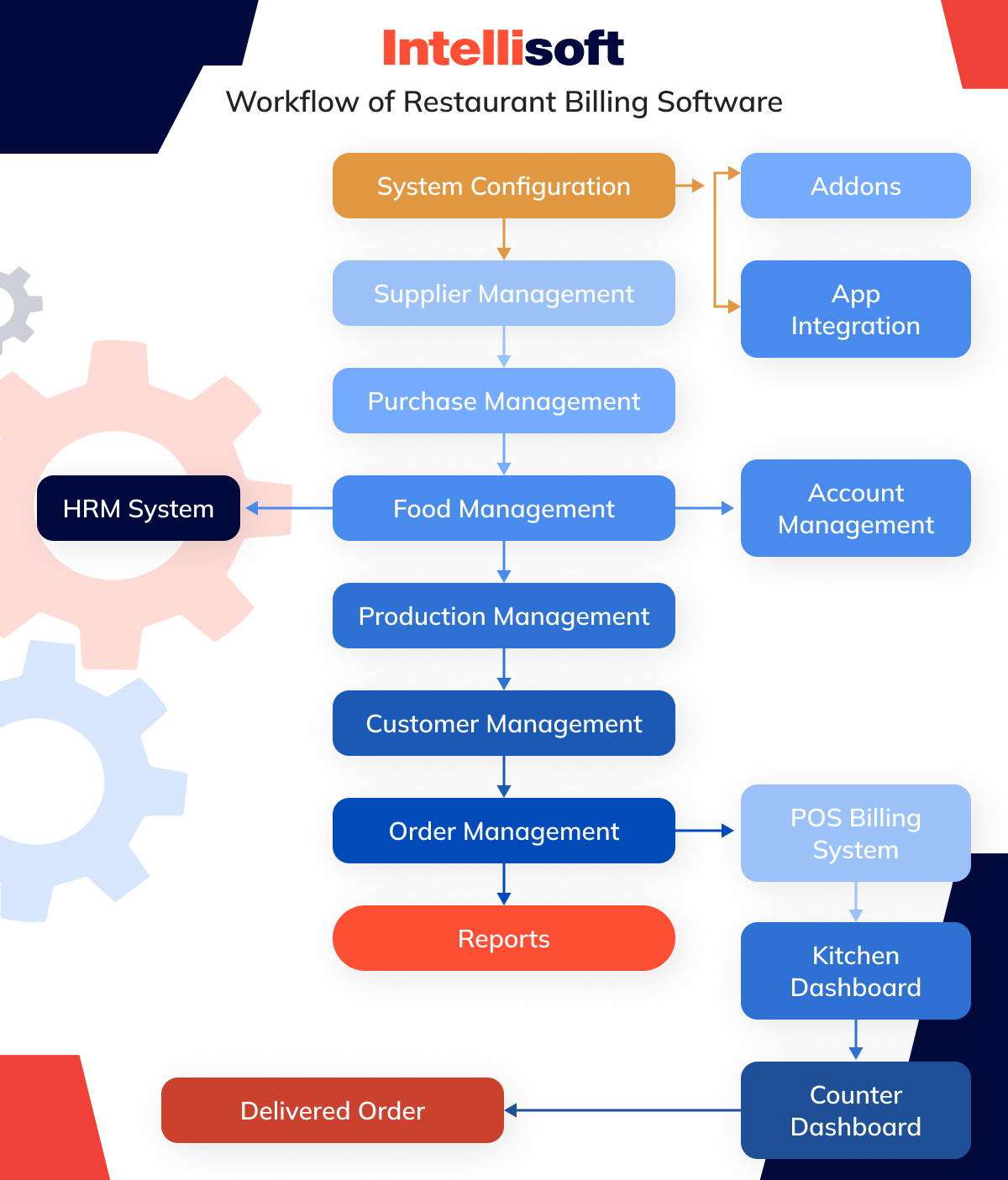
Why Do Restaurants Need a Restaurant Billing Software?
Why do restaurants need restaurant billing software? The answer lies in the complex and fast-paced nature of the hospitality industry, where efficiency, accuracy, and customer satisfaction are paramount. Let’s take a closer look at the reasons why a POS is a must for your business.

Automated and Centralized Management
The restaurant billing software automates and centralizes management to help restaurants streamline workflows. POS systems automate order processing, inventory management, and reporting, minimizing errors and fostering seamless coordination across departments.
Improved Customer Satisfaction
In the realm of hospitality, customer satisfaction reigns supreme. POS billing software for restaurant plays a pivotal role in elevating the dining experience by expediting transactions, reducing wait times, and offering flexible payment options. With quick and accurate billing, patrons are left impressed and content, fostering loyalty and positive word-of-mouth recommendations.
Security and Services
A high-quality POS system will help you increase security and improve customer service. These systems usually provide advanced security features to protect against potential breaches and ensure compliance with industry regulations. Moreover, they offer value-added services such as gift card processing, loyalty programs, and integrated feedback mechanisms, enhancing customer engagement and loyalty.
24/7 Accessibility
Software for restaurant billing is accessible 24/7, allowing users to operate the system at any time and from any location. Whether you’re monitoring sales trends, adjusting menu items, or analyzing performance metrics, accessing your POS system remotely empowers you to stay informed and responsive to evolving market dynamics.
Reduced Time Complexity
Time is precious in a restaurant’s fast-paced environment. Billing software automates tedious tasks such as order entry, bill calculation, and inventory tracking, freeing up valuable time for your staff to focus on delivering exceptional service and fostering meaningful interactions with customers.
Loyalty and Feedback System
POS systems have integrated loyalty programs and feedback mechanisms. These features help improve customer relationships and drive continuous improvement by collecting feedback and proactively responding to it. Moreover, you can reward loyal customers and foster brand loyalty by doing that. POS systems also help you gain valuable insights into how your restaurant is doing and enhance the overall dining experience.
Menu Management
Flexibility and agility are key in adapting to evolving consumer preferences and market trends. Restaurant billing software simplifies menu management, allowing you to easily update prices, add new items, or remove discontinued dishes with ease. This agility enables you to stay competitive and responsive to changing customer demands.
Improved Productivity
Efficiency breeds productivity, and billing software is a catalyst for both. POS systems enhance productivity across your establishment by automating repetitive tasks, minimizing errors, and optimizing workflows.
Accurate Billing
At the heart of every successful restaurant is transparent and accurate billing. Billing software ensures precision in every transaction, mitigating the risk of errors, disputes, and discrepancies that could tarnish your reputation. With seamless and accurate billing, you instill confidence in your patrons and uphold the integrity of your brand.
What Can Billing Software for Restaurant Do?
Restaurant billing software has multiple features and use cases based on your business needs. In general, it helps optimize everyday processes, assist with routine tasks, and improve customer and employee experience.
Order Management
First, a POS system should help you manage your restaurant’s orders, letting the staff input all orders and send them to the kitchen. The software helps track the orders, keep them in one place, and manage and change them if needed.
Billing and Payments
The key function of POS system is to deal with billing and payments, managing them properly. Thus, the system is linked to customer orders, making the billing process seamless. Your software should support multiple billing options and payment types.
Accounting Management
Restaurants produce hundreds of bills per day, and dealing with them manually can become impossible. A billing system helps deal with accounting management, helping restaurants with financial management. A POS automates invoice generation, expense tracking, and financial reporting, ensuring accuracy and saving time for the staff.
Insights and Analytics
A billing software analyzes all data entered into it, such as sales info, customer trends, and operational metrics. Thus, it allows you to gain actionable insights into the performance of your restaurant, identify areas of improvement, and optimize menu offerings based on what customers tend to order more often.
Inventory Management
Some POS systems also include an inventory management feature. This feature is crucial for proper cost control and keeping track of inventory. By using a POS system with an inventory management feature, you will be able always to keep track of the stock levels and usage patterns. You will be able to automate the restocking and reordering process. Including this feature in your custom software is essential to minimize waste, save costs, and optimize inventory turnover.
Related Readings
- Billing Software for Small Business: Maximize Efficiency
- Innovation Roadmap: When to Use a Proof of Concept or Prototype
- How to Build Enterprise Resource Planning (ERP) Software: a Complete Guide
- Detailed Guide On How to Develop a MarTech Platform
Best Restaurants Billing Tools
Do you want to explore the types of restaurant billing software systems available before deciding whether to go for a ready-made one or develop your own? We’ve compiled a list of the top restaurant billing tools with varying functionality to demonstrate how a functional and effective system should look. Let’s explore which is the best billing software for restaurant.
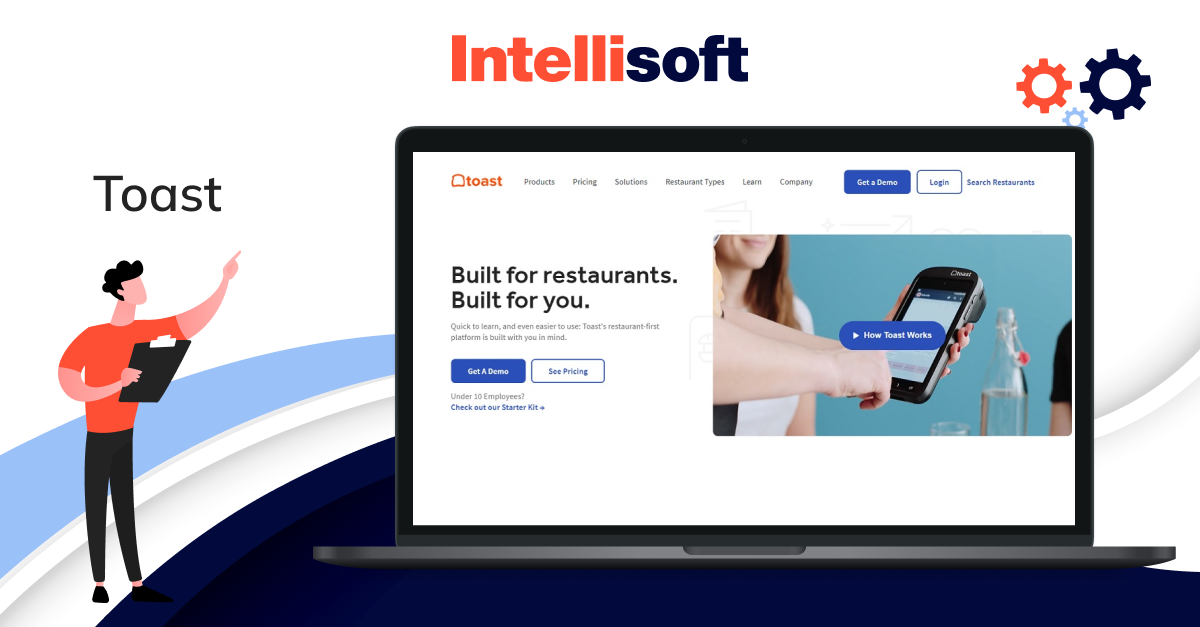
Main Features
- POS system for restaurants
- Kitchen display system
- Restaurant billing software free for PC
- POS hardware
- Payment processing
- Menu customization
- Inventory management
- Customer relationship management tools
- Integration with third-party apps and services
Pros
- User-friendly interface
- Reporting analytics capabilities help businesses make data-driven decisions
- Offers scalable solutions for small businesses and large enterprises
Cons
- Can be expensive for some businesses
- Some users report occasional glitches or technical issues with the software
TouchBistro
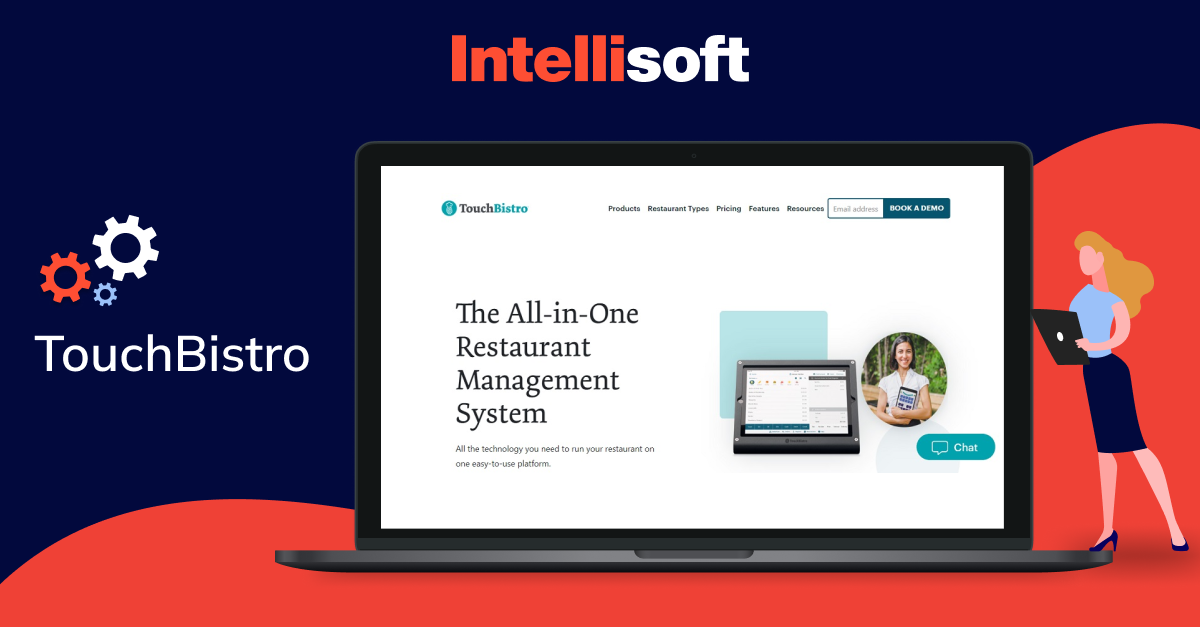
Main Features
- iPad-based POS system
- Payment solution for credit card processing
- Kitchen display system
- Customer display ordering
- Payment processing
- Customer engagement tools
Pros
- Intuitive interface and user-friendly design
- Excellent customer support and regular updates with new features
- Strong focus on the needs of the restaurant industry
Cons
Pricing structure may not be suitable for all businesses, particularly smaller establishments
SpotOn
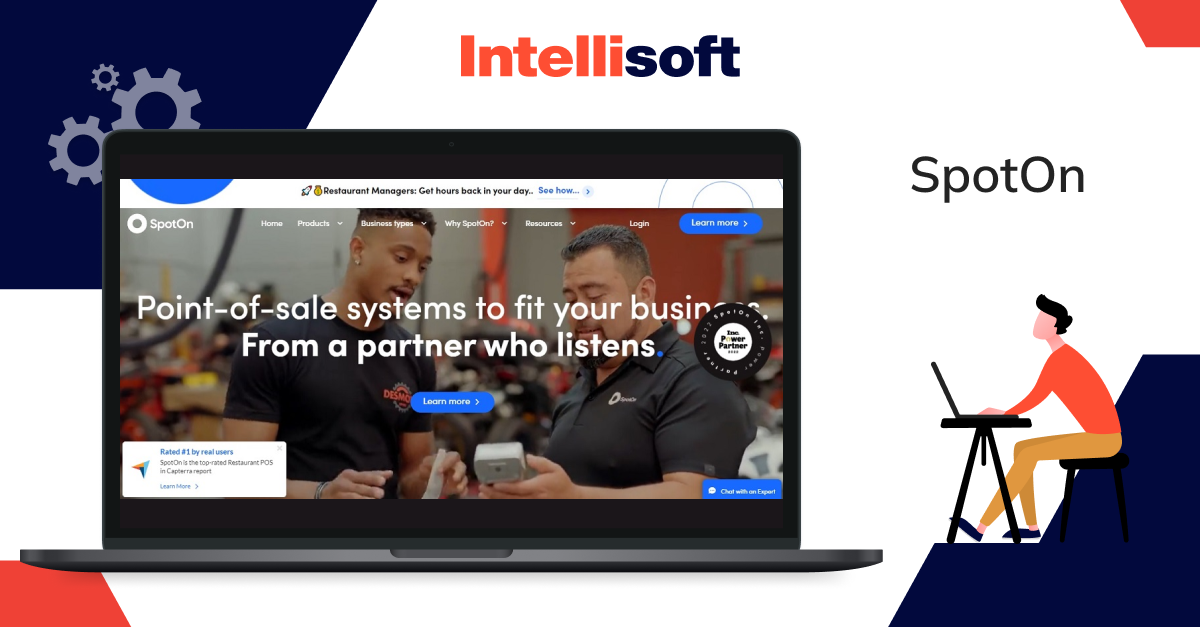
Main Features
- POS system
- Ability to accept payments anywhere
- Monichannel commerce solutions
- Easy to use for mobile vendors like food trucks
- Virtual terminal
Pros
- Perfect solution for front-of-house and back-of-house operations
- Customizable loyalty and marketing tools
Cons
Pricing structure may not be transparent, and costs can vary based on specific business needs
Square
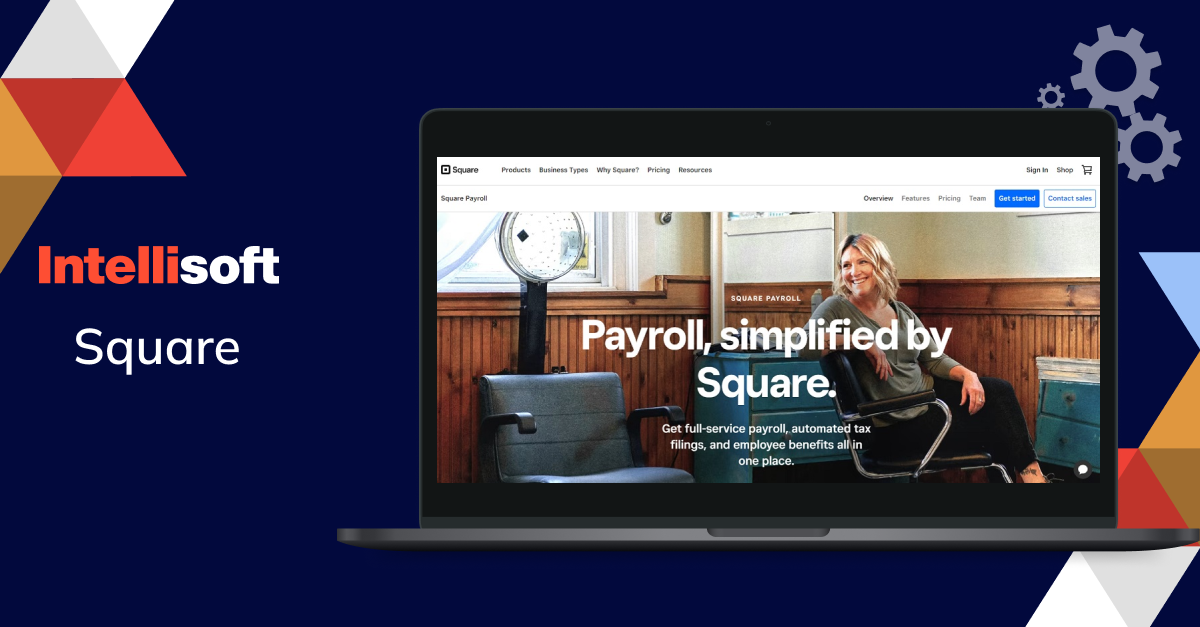
Main Features
- Accepts payments from anywhere
- POS for restaurants and retailers
- Its own dedicated hardware
- Billing and invoice management
Pros
- Straightforward pricing structure with transparent fees and no long-term contracts
- User-friendly interface and easy setup
- Extensive ecosystem of integrated services, including Square Online for e-commerce and Square Capital for financing
Cons
- Some advanced features may require additional fees or subscriptions
- Limited customization options compared to some other POS systems
Tabit
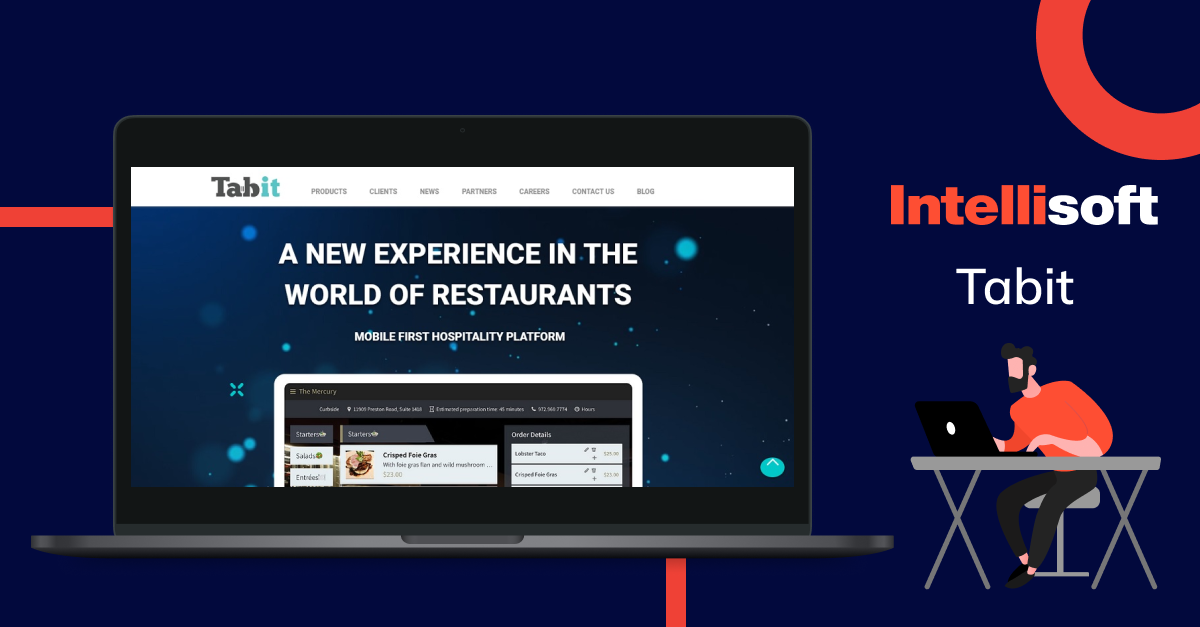
Main Features
- Mobile-first hospitality platform
- POS system
- Guest management solution
- Kitchen management platform
- Self-ordering kiosks
- Restaurant analytics
Pros
- Strong focus on customer engagement
- Offline functionality
- Streamlined interface and intuitive design
Cons
- Pricing structure may not be transparent, and costs can vary based on specific business needs
Choosing Between Ready-Made and Custom Solutions
How do you choose between a custom solution and a ready-made one? Let’s compare them and help you decide.
Ready-Made Solution
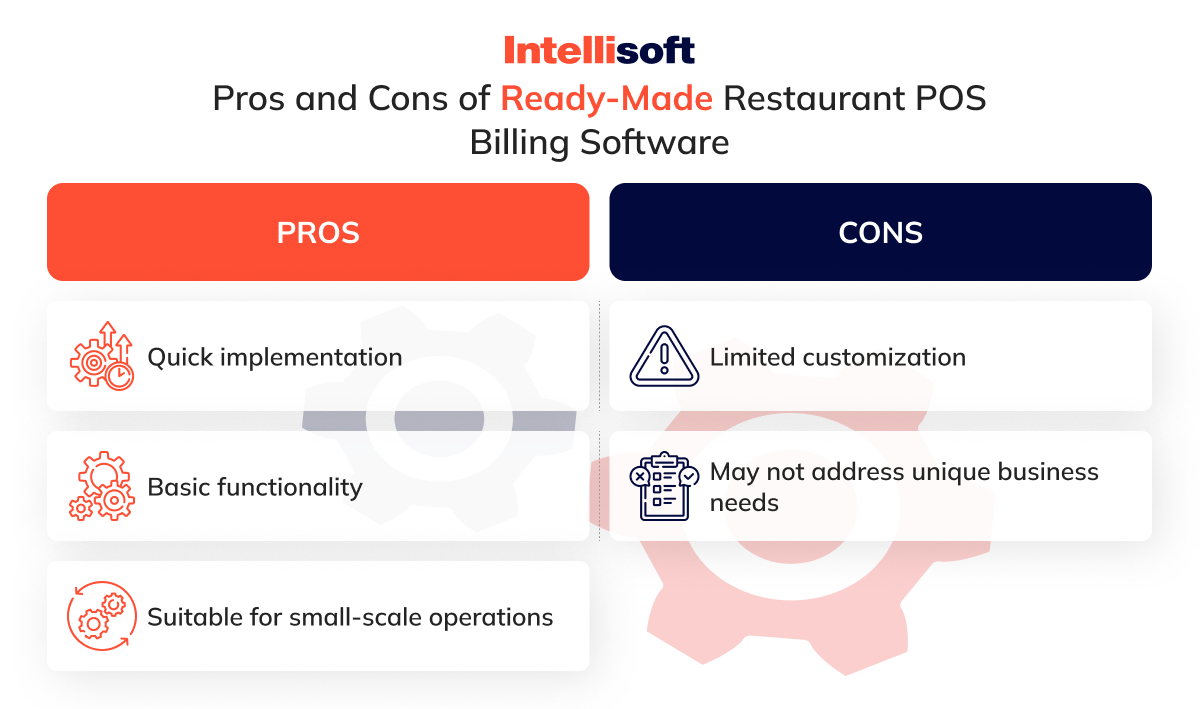
Custom Software
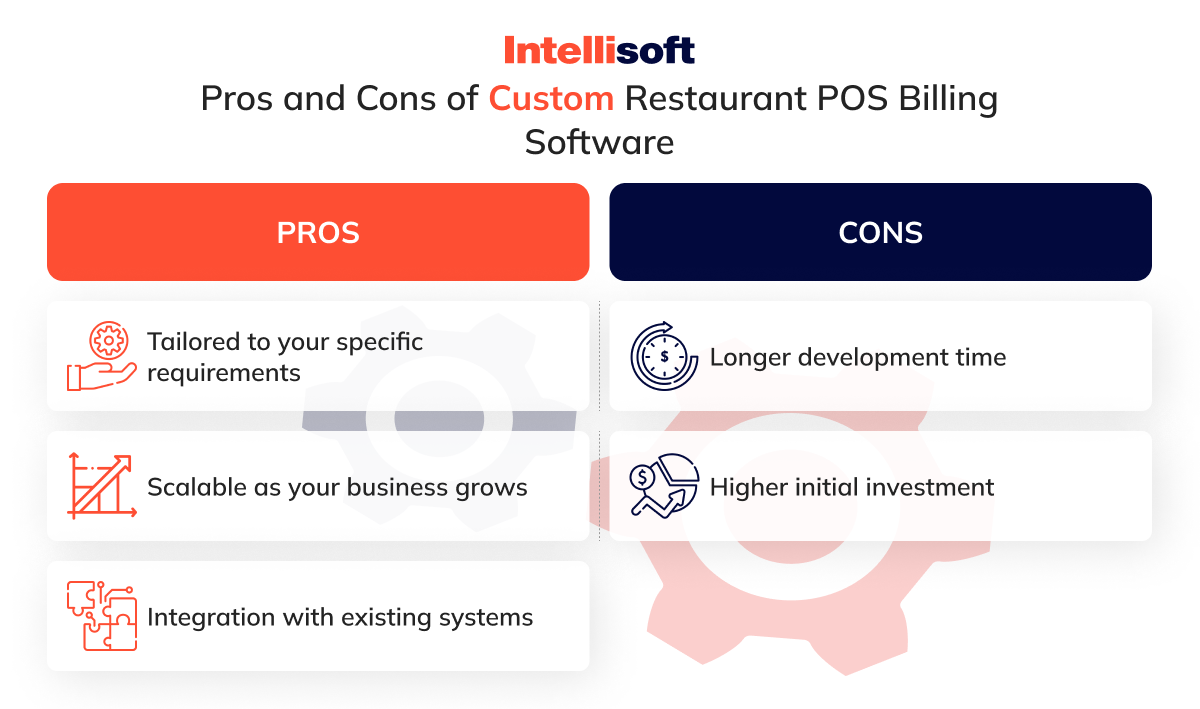
How to Develop a Restaurant Billing Software with a Software Development Company?
Ready to embark on a journey of developing restaurant billing software for your business but unsure where to start? The process is more than just finding a development partner and delegating the development process to them; it also involves a ton of brainstorming and ideation before you give a task to your dev partner.
You should clearly identify the “why” and “what” of development, asking these questions:
- What problems will your software solution solve?
- How many people will use it?
- Is your workload stable over the year or fluctuating?
Once you answer these questions and have a sense of direction, it’s time to proceed to the development.
Identifying the Software Requirements
Before diving into development, it’s crucial to identify the software requirements meticulously. This involves understanding the specific problems your software aims to solve within the restaurant billing process. From streamlining order management to enhancing billing accuracy, every requirement must be clearly outlined and prioritized.
Designing the Software Architecture
During the design phase, developers concentrate on crafting a robust and scalable architecture that establishes the groundwork for the software solution. This entails defining the structure, components, modules, and their interactions within the system. Based on the project’s requirements, developers select architectural patterns such as client-server architecture or microservices architecture. They create design documents such as system diagrams, flowcharts, and data models to communicate the architecture to both developers and stakeholders effectively.
Coding and Implementation
During the coding and implementation phase, developers translate the design specifications into functional code. They write code using chosen programming languages and frameworks while adhering to coding standards and best practices. This phase follows an iterative process involving regular code reviews, collaboration, and feedback loops to ensure the development of high-quality, maintainable code. Features and functionalities are added incrementally, tested, and refined throughout the development cycle.
Testing the Restaurant Billing Software
Testing plays a crucial role in validating the functionality, performance, and reliability of the software. Developers employ various testing techniques, including unit testing, integration testing, system testing, and user acceptance testing, to identify and rectify defects while ensuring compliance with specified requirements. They meticulously design test cases to cover all use cases and edge cases, utilizing automated testing tools to streamline the testing process. Moreover, developers incorporate feedback from users and stakeholders to fine-tune the software before deployment.
Deployment and Maintenance of Restaurant Billing Software
Once the restaurant billing software successfully passes testing, it will be deployed to production environments. This process involves installing the software on servers, configuring it for optimal performance, and integrating it with existing systems and databases. During this stage, the team conducts ongoing maintenance tasks such as monitoring system performance, applying patches and updates, and troubleshooting issues.
Ensuring Regular Software Maintenance
Consistently maintaining software is essential to keeping restaurant billing software up-to-date, secure, and responsive to evolving business needs. That is why the team monitors the system’s performance, addresses technical issues and bugs, and implements updates and enhancements. It is also essential to communicate regularly with stakeholders and users to gather feedback and improve the software.
Choosing the Right Technology Stack
Selecting the right technology stack is pivotal for the effective development of restaurant billing software. Let’s delve into the frontend development tools, backend development tools, and database management systems:
Frontend Development Tools
Frontend development involves creating the software’s user interface (UI) and client-side functionalities. Critical considerations for frontend development include:
- HTML/CSS/JavaScript. Fundamental building blocks for creating web applications, HTML provides the structure, CSS offers styling, and JavaScript adds interactivity.
- Frameworks and Libraries. Utilizing frontend frameworks such as React.js, Vue.js, or Angular can streamline development by providing reusable components and state management capabilities.
- Responsive Design. Ensuring the UI is responsive and accessible across various devices and screen sizes enhances user experience.
Backend Development Tools
Backend development focuses on the server-side logic and database management of the software. Important aspects of backend development include:
- Server Environment. Choosing a server-side environment such as Node.js, Python, Ruby on Rails, or Java depends on factors such as scalability, performance, and developer expertise.
- API Design. Designing robust and RESTful APIs for communication between the frontend and backend components is essential for data exchange and application functionality.
- Security. Implementing security measures such as authentication, authorization, input validation, and encryption safeguards the application against potential vulnerabilities and attacks.
Database Management Systems
Database management involves storing, retrieving, and managing data efficiently.
Considerations for selecting a database management system (DBMS) include:
- Relational vs. Non-Relational Databases. Choosing between relational databases (e.g., MySQL, PostgreSQL) and non-relational databases (e.g., MongoDB, Firebase) depends on factors such as data structure, scalability, and transactional requirements.
- Data Modeling. Designing an effective data model that reflects the application’s data requirements and relationships ensures efficient information storage and retrieval.
- Scalability and Performance. Assessing the scalability and performance capabilities of the chosen database system is crucial to accommodate growing data volumes and user traffic.
How Much Does It Cost to Build Custom Online Invoicing and Billing Software?
There’s no universally established price for developing online invoicing and billing software; the price depends on your business requirements, the team you’re working with, and the features you want the solution to include.
Here are the factors that influence the final price:
- Team Size and Location. The size and location of the development team play a significant role in determining costs. Development teams in regions with higher labor costs may charge more compared to those in lower-cost regions. Additionally, larger teams with more experienced developers may command higher rates but could potentially deliver the project faster.
- Add-Ons and Features. The complexity and breadth of features you want to include in your invoicing and billing software directly impact the cost. Basic software with essential features will be more affordable, while advanced functionalities such as automated invoicing, recurring billing, and integration with third-party platforms will increase development costs.
- Maintenance. Budgeting for ongoing maintenance is essential for ensuring the long-term functionality and performance of your software. This includes regular updates, bug fixes, and technical support. Factoring in maintenance costs upfront can help you avoid unexpected expenses down the line.
- Customization. Tailoring the software to meet your specific business requirements often involves customization, which can add to the development cost. Customization may include designing unique workflows, integrating with existing systems, or incorporating industry-specific features. The extent of customization required will influence the overall price.
Ready to embark on a journey to transform your restaurant processes and customer experience? Contact IntelliSoft, and let’s bring your business to new heights.
